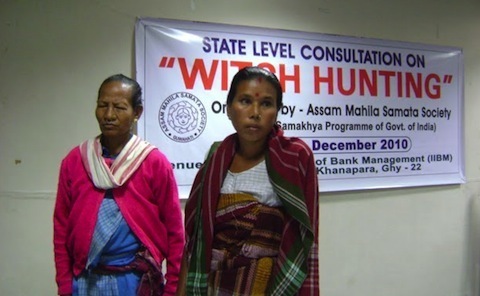Brendan I. Koerner's Blog, page 40
July 12, 2011
Mass Hysteria in Bangladesh

One of the issues I'll be exploring in my next book is the notion of psychological epidemics. How do certain behaviors go viral, and how do the arcs of such epidemics mirror those of their physiological counterparts? To this point, a lot of my research has focused on incidents of mass hysteria, which are endlessly fascinating and predictably weird. My weekend reading included this 2009 paper about a day-long hysteria epidemic in Bangladesh. Like so many instances of mass hysteria, the illness arose without warning:
Approximately 25 minutes after arriving at the Jaforabad high school on saturday , August 4th, 2007, a student of 8th grade noted 'feverishlike' feeling in his classroom; shortly thereafter he experienced vertigo, headache, nausea, burning in body, tingling sensation in limbs and dizziness. Similar symptoms soon developed in several students in his room. As the classroom was being evacuated, more students of different grades reported symptoms, and high grades of the school became panic area. Emergency medical personnel from nearby health complex, naming hathazari, rushed to the school within half an hour. The student who first reported symptoms (index case) and two other students were transported
to the hospital by taxi, in view of other students and teachers. Classes were canceled for the high grade from 6th to tenth grade, and that day, a total 15 learners went to the Headmaster room reported symptoms they believed were associated with exposure at the school; 3 of these learners were admitted to the hospital for observation overnight. The index student was among those hospitalized, but no explanation for his symptoms was found. Over the next two days, the school was examined by the Staff of health department including Consultant of Medicine and Upazilla Health and Family Planning Officer(UHFPO), the Local Education Officer, and state officials of the Upazilla Nirbahi Ofiicer, none of whom could detect a problem.
The authorities never did determine a root cause of the brief epidemic, but they did make one critical observation: every single affected student became ill after seeing another ill student, while no one who failed to witness a victim with their own eyes was stricken. In other words, the "virus" was transmitted by what the paper's authors term "line of sight."
This makes me think of the work now being done by Nicholas A. Christakis, well-known for his theories regarding the transmission of obesity and other lifestyle-related ailments along social networks. I wonder now if his model might extend to conditions that have much shorter life cycles, such as hysterical illness, as well as afflictions that are exclusively psychological in nature. In other words, if I witness one of my friends fly into a rage and punch out a window, does this raise the chances that I will do likewise over the next 24 to 48 hours?
July 11, 2011
The Single Step
So pretty momentous day here 'round Microkhan's new-ish Queens headquarters: after many weeks of inventing excuses to procrastinate, I'm finally starting to write my next book. It's due in April, so I reckon I have just enough time to craft the tale and fill in the remaining research gaps. But right now the endeavor seems truly daunting, as I try and dream up the perfect opening line. I've been wracking my brain, trying to remember how I concocted the opener for Now the Hell Will Start. (For the record, that book begins: "It is best to use discretion when confronting an emotionally shattered man, especially if he's holding a semiautomatic rifle.") But try as I might, the process seems to have slipped from my memory. Guess I have no choice, then, but to resort to trial-and-error; given what I know about that approach to writing, I expect the ensuing eight hours to be filled with little save pure frustration.
As I begin my proverbial thousand-mile journey with a single step, brighten your day with a little vintage Pete Rock and C.L. Smooth, taken from an old In Living Color episode. Yes, that is a permed-out Jennifer Lopez doing the intro.
July 8, 2011
The New Filibusters

When last we checked in on Bougainville's Panguna copper mine, there was considerable talk of reopening the long-shuttered operation—much to the consternation of indigenous groups who have long fought for a more equitable distribution of the proceeds. Now comes word that a few Americans might be sticking their nose in the island's business, thereby threatening Panguna's future:
The president of autonomous Papua New Guinea province of Bougainville, John Momis, says a shadowy American group, with links to a militant rebel group, is de-stablising his government.
The rebel group calling itself the Me'ekamui Tribal Nation, which refuses to acknowledge the government's legitimacy, reportedly has the backing of the so-called Tall J Foundation.
Mr Momis says he's met the Americans who he understands want to begin extracting alluvial gold in Bougainville.
"I don't know very much about them. All I know is that they're a menace. They are trying to sabotage all our efforts to create unity and a sense of responsibility, to get ourselves prepared for re-opening of the [Panguna] mine. They are more or less carpetbaggers, running around misleading ignorant people."
Okay, then, so what is the Tall J Foundation? Records are spotty, indeed—I couldn't find a corporate listing in the United States. from 2010 suggests that Tall J has been soliciting investors for some time now, with a fantastic promise of 500 percent returns. If the poster is to be believed, the company's director is one Stephen M. Strauss, with addresses in both Texas and Olive Branch, Mississippi. I got another pop on that exact name through a recent SEC case, in which a Stephen M. Strauss stands accused of orchestrating a pump-and-dump stock scheme while head of the Chilmark Entertainment Group. (One of the press releases alleged to have played a role in that scheme can be read here.)
Coincidence? Well, Chilmark was headquartered in Southhaven, Miss., just a stone's throw from Olive Branch, so I'm thinking the answer is "no."
The only other easily accessible trace of Tall J is this LinkedIn listing for one James Blackmore. But I can find no connection between Blackmore and Strauss—at least not yet.
The bottom line is that it seems that a tiny, shady-seeming investment concern actually appears to be wreaking genuine havoc on the Bougainville peace process. That immediately made me think of such infamous 19th-century filibusters as William Walker, who fomented great chaos in Latin America in the service of making fortunes. This is why private interests really shouldn't be permitted to assume roles that might destabilize shaky governments; corporate self-interest is typically more at odds with international order than diplomatic self-interest.
July 7, 2011
Keeping It Far Too Real: The Blackjack Ward Story
 While snooping about some old Google-able papers the other day, I stumbled across this true-crime tidbit about a 1940 murder case involving a pair of Hollywood extras. The killing took place in Gower Gulch, a street corner where former cowboys would gather in hopes of being picked to appear in B-grade Westerns—much like day laborers now congregate in shopping-mall parking lots with an eye toward scoring sheetrocking work. The Unsung Joe picks up the story from there:
While snooping about some old Google-able papers the other day, I stumbled across this true-crime tidbit about a 1940 murder case involving a pair of Hollywood extras. The killing took place in Gower Gulch, a street corner where former cowboys would gather in hopes of being picked to appear in B-grade Westerns—much like day laborers now congregate in shopping-mall parking lots with an eye toward scoring sheetrocking work. The Unsung Joe picks up the story from there:
At any time of day, between 25 and 50 characters in Stetsons and checked shirts could be seen on the sidewalk, killing time and — because all these men had once been genuine cowboys, unlike the cowboy stars like Roy Rogers or Gene Autry — reminiscing about the old days before the great ranches of the west had been broken up into farms and homesteads, when they'd been able to get real work driving cattle across the open range…
Blackjack Ward was one such man. He'd been a range rider most of his life, and claimed to have served as Pancho Villa's right-hand man in the Mexican revolution of 1910(1) but, by 1927, when he was in his late 30s, the scarcity of work on the range had brought him to Hollywood. His skill on horseback kept him busy in the hundreds upon hundreds of westerns that required competent riders, and his villainous scowl and expressive eyes secured him plenty of work as background henchmen…
On the morning of February 23, 1940, around 50 cowboy extras were standing around outside the drugstore on the corner of Gower and Sunset. Blackjack was there, and so was Johnny Tyke, another western bit-part player who had an impressive criminal record and was currently wanted by the police in connection with a string of hold-ups.
"I had known Tyke for quite a while — I fed and helped that varmint for years," said Blackjack. "A few months ago, he was in jail for drunk driving, but I didn't go to see him and, when he got out, he kept pestering me because of it. We had arguments and he threatened me. One day he said he was going to beat me to death or else use his Bowie knife on me.
"Well, we met in the drugstore where the boys hang out, and Tyke started in again. He got real abusive and called me names no man worth the powder to blow him to hell will take back where I come from in old Arizona, but I says, 'Look here, you're bigger than me and you probably could whip me. There ain't no sense to this anyway, and I don't want no trouble.'
"I got in my car and started to drive away. Tyke jumped in front of the car and yelled, 'No you don't. Let's settle this right now.'
"Well, I usually carry my old gun with me; just a sort of habit a man gets into when he spends a lot of time riding the range. When Tyke tried to get in the car, I shot at him once through the windshield and drove off."
Read the rest of the account for details on how the killing divided the henchmen community, and how Ward could never quite escape the claws of justice after his run-in with Tyke. The piece leaves me wondering, though, about the economics of the Hollywood system back then. What sort of life could one lead on a henchman's salary? And how might it compare to what modern-day bit players are able to eke out?
July 6, 2011
Justice Too Swift

Years back, in an effort to quell football fan violence, authorities in Philadelphia set up a courtroom at Veterans Stadium, so that drunken brawlers could be punished within minutes of being arrested. Sure, such a legal arrangement wasn't in the constitutional spirit, since the accused weren't permitted legal representation or a chance to review the charges against them. But no one could get too worked about the plight of Eagles fans, who are far from a popular bunch.
The same cant be said for Bangladeshi protestors, who are now taking to the streets to voice their opposition to a key electoral change. One of the government's key weapons against these strikers is a system of mobile courts, ostensibly set up to enforce the nation's anti-tobacco laws. In reality, though, the courts are being used to route around the rule of law:
It is well and true that the Mobile Courts Act 2009 gives almost unfettered discretion to mobile courts to "hold a person guilty". It is in this unrestricted discretion that the illegality and unconstitutionality of this system lies. The "super power" given under the Act to mobile courts means that these courts are absolved of all the procedural and evidential requirements that exist to protect the rights of an accused person – the right to consult a lawyer, the right to defend himself, the right to cross-examine the prosecution's evidence, the right to produce his own witnesses, the right to make a closing argument explaining his story to the court and so on. None of these rights exist for a person whom a mobile court has got a hold of and, unfortunately for him, the age-old principle – "Innocent until proven guilty" stands corrected as "Guilty until proven innocent".
The courts remind me of something I reported on for Now the Hell Will Start: the military's use of special courts-martial during World War II. The proceedings were designed to be as expedient as possible, so that the Army could get on with its main job of fighting the Axis. But in practice, the utter lack of legal protections for defendants meant that commanding officers could effectively punish at will for any minor infraction. In Bangladesh, that power is now in the hands of riot police, whose accusations obviously carry the most weight at mobile court proceedings. No good can possibly come of that.
(Photo for Reuters by Andrew Biraj)
July 5, 2011
Dodging Zeus

Virtually every ancient mythological system included a deity who was fond of hurling lightning bolts at unfortunate humans. Concocting the notion of such violence-from-above certainly took little imagination on the folklorists' parts, since lightning fatalities were commonplace in bygone times. In fact, as the chart above shows, it is not until quite recently that the American population has become urbanized enough to make lightning deaths a true rarity. The equation is fairly simple: the less time a nation's people spend toiling in the fields, the less likely they are to be killed by lightning.
That axiom is cold comfort to countries that still experience high numbers of lightning-related fatalities and injuries, of course. A Nigerian tragedy recently made headlines, but it is Bangladesh that bears the brunt of the world's misery here: a quarter of the 24,000 deaths attributed to lightning each year occur in the massive South Asian nation. (See how lightning stacks up against other natural disasters here.) Assuming that urbanization in Bangladesh and similarly afflicted countries continues apace, the problem should decrease over the decades. But in the meantime, is there a quick-and-easy solution to saving thousands of rural dwellers each year?
This is one of the rare instances in which my skepticism about public-education campaigns melts, and I see the wisdom in simply spreading the word about the dangers of electrical storms. As emphasized in this account of Cambodia's recent bout with lightning, farm workers remain appallingly unaware of both the hazards of the phenomenon, as well as the appropriate ways to minimize their chances of getting hit. Perhaps there is a role for NGOs to play, by sponsoring the building of simple lightning-proof lean-tos where farmers can take refuge when caught out in the fields. (Anything beats hiding under a tree.) But the humble pamphlet or (give literacy rates) public lecture may be the real savior here.
More on historical trends in lightning fatalities here (PDF).
July 1, 2011
Turning the Corner
A million things to do before the long weekend kicks in, starting with a journey back to Harlem to snake a drain. (No, this isn't a euphemism.) Hope y'all have something special planned for the holiday, and see you back here next week. If you have a spare moment before then, though, I highly recommend this vintage (and sadly unembeddable) video of Dutch motoball circa 1982.
June 30, 2011
"The One That Shall Not be Named"
Friend o' Microkhan is the man most responsible for hipping me to the post-baseball travails of Pedro Guerrero. He is also an immensely talented writer and director whose latest project, Dragonslayer, justifiably took home top honors at the latest SXSW Film Festival. Patterson himself provides a summary of the film that makes it sound nothing short of irresistible:
I met Josh Sandoval at a party in an abandoned airfield off the I-10 in Chino, California. He had a lime-green Mohawk and was wearing a matching Screamers T-shirt, in honor of the L.A. punk band that never recorded an album. He looked malnourished and lost, and claimed he was on 5 tabs of acid. It was impossible to talk to him. His head was lost in the clouds. Then I saw him skate. I think Josh is like a lot of kids from his generation–smart enough to know a potentially bleak future looms and scrambling to figure out a way to survive in it. He's also on a wavelength all his own.
Dragonslayer is my attempt to capture this wavelength and preserve it: a portrait of a new generation of kids from the rotting suburbs of inland California, and a celebration of what makes one of them so unique.
Great Los Angeles Times write-up here. No release schedule yet, as the movie is still making the festival rounds. But follow Tristan here for word on where to catch his fuzzed-out masterpiece this fall.
June 29, 2011
Witch Hunting in Assam

So far this year, Microkhan's coverage of sorcery-related violence has focused primarily on Papua New Guinea, where efforts at legal reform have done little to reduce the bloodshed. Now comes word that my beloved Assam, one of the primary settings for my first book, is dealing with a similarly tragic wave of killings. The latest incident on one of the Indian state's tea plantations pushed this year's death toll to at least 18, with several of the victims under the age of 12. Perhaps even more so than their compatriots in Papua New Guinea, Assamese authorities are struggling to devise a way to cope with the epidemic:
Many police officers feel that the State should have a special legislation to deal with the menace of witch hunting. Police sources pointed out that at present, the witch hunting cases are registered as normal murder cases and it is difficult to go for proper documentation of such cases. Moreover, when a whole village is involved in a case, it is difficult to pinpoint the main culprit and it is almost impossible to collect evidence as no one comes forward to testify against anyone. Several other States including Bihar and Jharkhand have already enacted special legislation to deal with witch hunting and it is high time Assam also makes such legislation in the face of spurt in such cases.
The bolded point is key, as most of these attacks do seem to be cases of collective violence. As pointed out here, the slayings are often sparked not by genuine concern over sorcery, but by disputes over property or romantic jealousy. If one of the parties in such a dispute is cynical enough, he can settle the matter by accusing his adversary of black magic, thereby getting his superstitious fellow villagers to take his side and settle the matter through violence. No one tattles because to do so would be to destroy the entire village, since everyone is partially culpable in the killings.
The Assam Police are doing their best by reviving a targeted education campaign called Project Parhari, which aims to disabuse villagers of the notion that malicious sorcery is real. But government representatives can only spend so much time in each settlement, spreading their message of reason. Perhaps the better long-term solution is to provide villagers with better means of dispute resolution—and to ensure that justice is swift and certain when killings do occur, even if it means carting off every single participant.
(Image via TwoCircles.net)
June 28, 2011
Who's Hero?
 Though my ability to feed my family depends entirely on humankind's affinity for written communication, I'm often surprised by the power of words. Case in point: the developing brouhaha between Hungary and Romania over a plaque tacked onto a statue of King Matthias (right). The monument is located in the Romanian town of Cluj, where the 15th-century Hungarian monarchy was born. When the local council recently restored the statue, it tacked on a descriptive sign that, due to a single sentence fragment, threatens to poison relations between neighboring NATO members. The plaque's sin? It quotes from a Romanian historian who seems to believe that King Matthias wasn't really Hungarian at all:
Though my ability to feed my family depends entirely on humankind's affinity for written communication, I'm often surprised by the power of words. Case in point: the developing brouhaha between Hungary and Romania over a plaque tacked onto a statue of King Matthias (right). The monument is located in the Romanian town of Cluj, where the 15th-century Hungarian monarchy was born. When the local council recently restored the statue, it tacked on a descriptive sign that, due to a single sentence fragment, threatens to poison relations between neighboring NATO members. The plaque's sin? It quotes from a Romanian historian who seems to believe that King Matthias wasn't really Hungarian at all:
In May Hungarian ambassador Oszkár Füzes was stopped by police from placing flowers on a controversial plaque put in front of a statue of medieval Hungarian King Mátyás (Matthias) in the ethnic Hungarian town of Cluj. The plaque, noting a rare battlefield loss by Mátyás to Moldavian forces in 1467, read "he suffered defeat at the hands of his own nation."
The Romanian Culture Ministry said the inscription had not been approved by the state historical commission and is therefore illegal. However, Cluj town hall claims it proceeded within the law.
More on the ensuing controversy here. As you might imagine, hardcore nationalists on both sides of the Romanian-Hungarian divide have been using the plaque to make political hay. It all seems nonsensical to my thoroughly American brain, especially given the fictional nature of "pure" ethnicity. Wouldn't an intermingling of genes (and thus heritages) be the norm in an interzone like Cluj?
But some people thrive on a sense of grievance, and thus look for every opportunity to feel as if their identities are being threatened by exceedingly minor slights. Unfortunately, these insecure actors tend to have a disproportionate voice in politics, to the detriment of rational discourse. And so a few words on an obscure plaque end up having serious implications for people who otherwise couldn't tell King Matthias from King Tubby.




